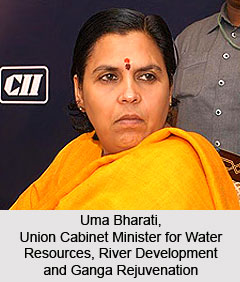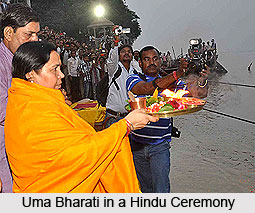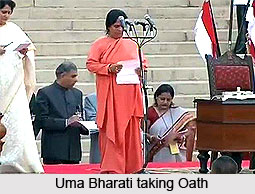 Uma Bharati is an Indian politician with an image of a vigorous believer of Hindu Philosophy. She is now the Union Minister for Water Resources, River Development and Ganga Rejuvenation in Union Government of India, which is formed after the enormous victory of NDA and BJP in 2014 Indian general election.
Uma Bharati is an Indian politician with an image of a vigorous believer of Hindu Philosophy. She is now the Union Minister for Water Resources, River Development and Ganga Rejuvenation in Union Government of India, which is formed after the enormous victory of NDA and BJP in 2014 Indian general election.
Early Life of Uma Bharti
Uma Bharti was born on 3rd May 1959, and was referred with an honorific title "Sadhvi". She came in the limelight with the help of Vijaya Raje Scindia of Gwalior. She belongs from Dunda, Tikamgarh District, Madhya Pradesh, to a family of peasants. Uma Bharti attended the school up until the sixth standard. As a child, Uma Bharti displayed substantial attention in reading the Hindu religious texts like the Bhagvad Gita, Upanishad, Mahabharata and Ramayana, which led to her being seen as a "spiritual" child. Uma Bharti began to give spiritual discourses while she was a child. This brought her into contact with Rajmata Vijayaraje Scindia of Gwalior, who would later become her political mentor with time.
Political Career of Uma Bharti
Uma Bharti became involved with the Bharatiya Janata Party (BJP) at a very young age. She was unsuccessfully in contesting her first Parliamentary elections in 1984. In 1989,
 she successfully contested the Khajuraho (Madhya Pradesh) seat, and retained it in elections conducted in 1991, 1996 and 1998. In 1999, she contested in the constituencies and won the Bhopal seat. Under the Government of Atal Bihari Vajpayee, she held various state-level and cabinet level portfolios of Human Resource Development, Tourism, Youth Affairs and Sports, and finally Coal and Mines ministry in Union Government of India.
she successfully contested the Khajuraho (Madhya Pradesh) seat, and retained it in elections conducted in 1991, 1996 and 1998. In 1999, she contested in the constituencies and won the Bhopal seat. Under the Government of Atal Bihari Vajpayee, she held various state-level and cabinet level portfolios of Human Resource Development, Tourism, Youth Affairs and Sports, and finally Coal and Mines ministry in Union Government of India.
Uma Bharti was one of the most prominent leaders of the Ram Janmabhoomi movement of the 1980s and 90s organized by the BJP and the Vishva Hindu Parishad. In the 2003 Assembly polls, she led the BJP to a three-fourths majority in the Madhya Pradesh assembly. She defeated her opponent, a candidate of Indian National Congress, from the Malehra seat.
Rise to Fame
With the support of Rajmata Viyayaraje Scindia, Uma Bharti involved with the BJP`s regional seat of Madhya Pradesh state while still in her twenties. In 1984, she contested Lok Sabha elections for the first time, but lost the election in the Indian National Congress wave that followed the assassination of Indira Gandhi. In the year 1989, Uma Bharti won her first Lok Sabha seat from the constituency of Khajuraho in Madhya Pradesh, and retained the seat in the elections of 1991, 1996, and 1998.
 Uma Bharti came into the spotlight of national politics, when she became one of the major faces of the Ramjanmabhoomi movement alongside Lal Krishna Advani and others members of BJP. In December 1992, Uma Bharti became one of several prominent figures of Sangh Parivar to present at a rally in Ayodhya.
Uma Bharti came into the spotlight of national politics, when she became one of the major faces of the Ramjanmabhoomi movement alongside Lal Krishna Advani and others members of BJP. In December 1992, Uma Bharti became one of several prominent figures of Sangh Parivar to present at a rally in Ayodhya.
Uma Bharti was appointed as the Chief ministerial candidate of the Bharatiya Janata Party for the 2003 Assembly Polls in Madhya Pradesh. On the back of a fierce campaign based on a board of development, and helped along by her reputation as a Hindutva firebrand, she led the party to a three-fourths majority in the legislature. Due to the internal strife in BJP, she was expelled from Bharatiya Janata Party. But she was re-inducted in BJP on June 7, 2011. On 16 May 2014, after the huge victory in Indian General Election conducted by Election Commission of India, she was elected to the Lok Sabha from Jhansi constituency by defeating Chandrapal Yadav of the Samajwadi Party. On 26 May, 2014, she was appointed as the Minister for Water Resources, River Development and Ganga Rejuvenation in the cabinet of Narendra Modi.






